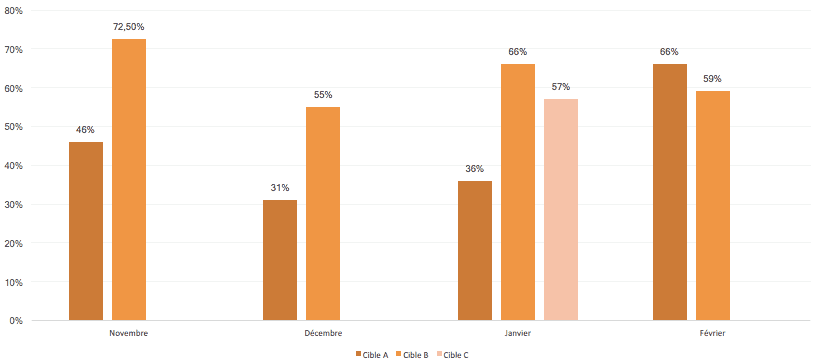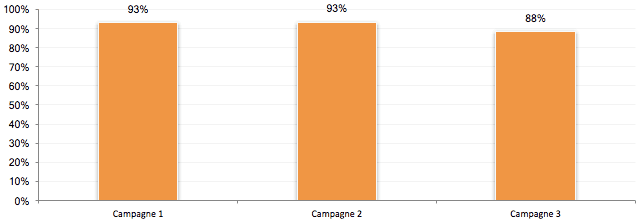What is the email dissatisfaction rate?
The dissatisfaction rate correlates the number of clicks on the unsubscribe link and the overall number of clicks of a campaign. The dissatisfaction rate allows to show the level of dissatisfaction of an email campaign, thus the strong risks of having deliverability problems (on one or more ISPs/Webmails) on your short/medium term marketing campaigns.
It therefore makes it possible to identify problematic campaigns and to rectify them.
How is it measured?
The dissatisfaction rate is very simple to calculate.
All you have to do is take the cumulative number of clicks on the unsubscribe link and divide it by the cumulative number of clicks (clicks on the different links + clicks on the unsubscribe link). You multiply the resulting figure by 100 and you have your dissatisfaction rate.
It is assumed that:
- Dissatisfaction rate < 20% (i.e. less than 2 out of 10 people who unsubscribed): your subscribers are quite satisfied with your mailing.
- Dissatisfaction rate between >=20% and =< 40% (between 2 to 4 people out of 10 have unsubscribed): we can see the beginning of dissatisfaction, there is still time to react by analyzing the content of the message and the segment used.
- Dissatisfaction rate > 40% (more than 4 out of 10 people have unsubscribed): dissatisfaction is very high, delivery problems may already be visible. Did you really send the right message to the right person? Was your database well optimized before being used?
What is it used for and when should it be monitored?
You will say to me but why to supervise it if all is well or almost well...
Simply because, thanks to it, you can easily escape from a disaster. Remember that you only need one campaign to lose your reputation but it will take you several weeks (or even months) to regain it. So a significant saving of time and energy 🙂
It could also be interesting to integrate it into your deliverability monitoring :
- You want to know where your subscribers stand in relation to your various email communications.
- You have just acquired new addresses indirectly. This can help you to know how the new target reacts to your e-mails.
- You are launching a new product/service. This can help you to know how it will be perceived and if it is adapted to your subscribers.
- You're in a sales period and you want to target a little more (or a lot more for some :p) wide. This rate allows you to set the limits not to exceed.
Some examples...
During the last deliverability audits that I conducted, I realized that the rates of dissatisfaction were very variable and the causes very diverse.
I will share with you these experiences (anonymizing the companies of course).
Case 1: We have openers, we have clickers but very little transformation... Why?

Dissatisfaction rates show a very strong dissatisfaction (more than 8 out of 10 people click on the unsubscribe link).
Questions to ask:
- Is the database opt-in? Has it been properly qualified before being used?
- Is the proposed offer really adapted to the target?
Case 2: Our view scores are quite low, we would like to improve our performance on our next campaigns.

The dissatisfaction rates by target show a more or less strong dissatisfaction (between 3 and 7 people out of 10 unsubscribe).
Questions to ask:
- Is the proposed content really adapted to the target?
- Is Target B opt-in?
Case 3: We have just bought a new base. The first tests performed on it are very weak, why?

Like case 1, the dissatisfaction rates show a very strong dissatisfaction (almost 9 out of 10 people click on the unsubscribe link).
Questions to ask:
- Is the database opt-in? Has it been properly qualified before being used?
- Is the proposed offer really adapted to the target?
Conclusion
Little known and above all little monitored, the dissatisfaction rate is a key indicator that deserves, just like the opening rates - the bounce rates - the complaint rates, to be monitored more closely.
The calculation is simple (especially if your router provides you with the data directly) and the accuracy is effective.
To your calculators now 🙂
One Response
"Case 3: We have just purchased a new base.
[…]
Questions to ask:
Is the base opt-in? "
The question to ask is "how long can I continue to send everything with such practices?